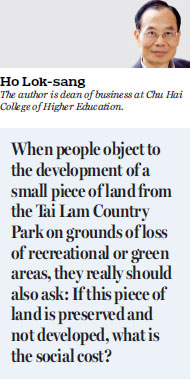Consider both costs and benefits in land development
Updated: 2017-02-14 07:14
By Ho Lok-sang(HK Edition)
|
|||||||
Development control and land development happen to be a subject that I studied at graduate school at the University of Toronto. Land development is definitely a complicated subject because there are so many stakeholders, but the economic principles are surprisingly simple. Unfortunately, few of those who participate in the policy debate about land development appear to have a sense about these principles.
Actually, land development, like all economic activity, should be based on costs and benefits. Here costs and benefits must, however, refer to social costs and benefits. Social costs include all the costs that society needs to bear for each development project. Direct costs aside, the loss of a natural habitat and sacrifice in terms of biodiversity and ecologically sensitive or historical valuable sites must also be included, as must disruption to existing communities. On the benefit side, we need to consider the increase in the number of homes, improvement in amenities, transportation, employment opportunities, and business opportunities that may be afforded by the development. When we ponder whether or not to develop a piece of land or reclaim more land from the ocean, we must also consider both costs and benefits. Moreover, even when we can show a net benefit from development, we need to identify which kind of development will bring the biggest benefits to the community.

Sadly, those who object to development today will only mention the costs but seldom compare the costs with the benefits. When people object to the development of a small piece of land from the Tai Lam Country Park on grounds of loss of recreational or green areas, they really should also ask: If this piece of land is preserved and not developed, what is the social cost?
Wong Fook-yee, a retired assistant director of the Agriculture, Fisheries and Conservation Department, said that the northeastern corner of the Tai Lam Country Park is a great area for picnicking and hiking. It therefore meets all the criteria for preservation as country parkland. He admitted that the ecological value of the land may not be high, but it is eminently accessible. Using it for development will mean the loss of a convenient accession point to the country park, and building homes may also lead to the shrinkage of a water collection area for the reservoir.
Everything Wong said is true. But he failed to mention the social costs of preservation! Lau Ping-cheung, a surveyor and chairman of the Hong Kong Coalition of Professional Services, estimated that the land can provide homes for 30,000 households. This means that 30,000 families could enjoy a major improvement in living conditions and savings in rent in the years to come. Accommodation is a basic requirement which is needed in order to enjoy a good livelihood. If Wong is concerned about the recreational needs of Hong Kong citizens, should he not also be concerned about the needs of tens of thousands of Hong Kong families? Better living conditions and fewer financial pressures may also mean longer life expectancy. More importantly, the land under consideration is less than 2 square kilometers. After the proposed public housing development, Hong Kong people continue to have more than 400 square kilometers of country parks.
Of course, Hong Kong needs its country parks, and the Country Park Ordinance is a great piece of legislation. It has served Hong Kong well since its enactment in 1976. But this is more than 40 years ago, and Hong Kong's population has grown from 4.5 million to 7.4 million. Despite the increase in our population, we now conserve more land than we did in 1976! In 1979 we only had 21 country parks; today we have 24 and, in addition, we have 22 special areas. The total area of land designated for preservation now covers 44,300 hectares, or 443 square kilometers. Meanwhile, only about 77 square kilometers or 7 percent of Hong Kong's total area is residential land. This includes 35 square kilometers of very low-density rural settlements. This means more than 90 percent of Hong Kong's families have to live in just 42 square kilometers.
We are all proud of Hong Kong's country parks; I have no doubt over the long run we will still retain well over 400 square kilometers of country parks. Yet what is the rationale for "not giving up an inch of land" from the country parks, as some noted conservationists including the former director of the Hong Kong Observatory Lam Chiu-ying have maintained?
There are some who think that once they "give in" to any request to take land out of the country parks the "inroads" into country parks will continue, and the sacrifice will become unbearable. I would propose that the government enlist Hong Kong's top conservationists into the decision-making body that will oversee land development from our country parks and green areas. As an optimist, I trust that, with an open mind, the SAR will work its way out of the present impasse, and that we will all work together for a better Hong Kong.
(HK Edition 02/14/2017 page7)